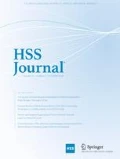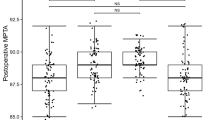Abstract
Background
Component malposition is one of the major reasons for early failure of unicompartmental knee arthroplasty (UKA).
Questions/Purposes
It was investigated how reproducibly patient-specific instrumentation (PSI) achieved preoperatively planned placement of the tibial component in UKA specifically assessing coronal alignment, slope and flexion of the components and axial rotation.
Patients and Methods
Based on computer tomography models of ten cadaver legs, PSI jigs were generated to guide cuts perpendicular to the tibial axis in the coronal and sagittal planes and in neutral axial rotation. Deviation ≥3° from the designed orientation in a postoperative CT was defined as outside the range of acceptable alignment.
Results
Mean coronal alignment was 0.4 ± 3.2° varus with two outliers. Mean slope was 2.8 ± 3.9° with six components in excessive flexion. It was noted that the implants were put in a mean of 1.7 ± 8.0° of external rotation with seven outliers
Conclusions
PSI helped achieve the planned coronal orientation of the component. The guides were less accurate in setting optimal tray rotation and slope.






Similar content being viewed by others
References
Berend KR, Lombardi AV Jr, Adams JB. Obesity, young age, patellofemoral disease, and anterior knee pain: identifying the unicondylar arthroplasty patient in the United States. Orthopedics. 2007; 30(5 Suppl): 19-23.
Berger RA, Rubash HE, Seel MJ, Thompson WH, Crossett LS. Determining the rotational alignment of the femoral component in total knee arthroplasty using the epicondylar axis. Clin Orthop Relat Res. 1993; 286: 40-47.
Cartier P, Sanouiller JL, Grelsamer RP. Unicompartmental knee arthroplasty surgery. 10-year minimum follow-up period. J Arthroplasty. 1996; 11(7): 782-788.
Cossey AJ, Spriggins AJ. The use of computer-assisted surgical navigation to prevent malalignment in unicompartmental knee arthroplasty. J Arthroplasty. 2005; 20(1): 29-34.
Diezi C, Wirth S, Meyer DC, Koch PP. Effect of femoral to tibial varus mismatch on the contact area of unicondylar knee prostheses. Knee 17(5):350–5.
Hafez MA, Chelule KL, Seedhom BB, Sherman KP. Computer-assisted total knee arthroplasty using patient-specific templating. Clin Orthop Relat Res. 2006; 444: 184-192.
Hernigou P, Deschamps G. Posterior slope of the tibial implant and the outcome of unicompartmental knee arthroplasty. J Bone Joint Surg Am. 2004; 86-A(3): 506-511.
Heyse TJ, Figiel J, Hahnlein U, et al. MRI after unicondylar knee arthroplasty: rotational alignment of components. Arch Orthop Traum Surg. 2013.
Heyse TJ, Khefacha A, Peersman G, Cartier P. Survivorship of UKA in the middle-aged. Knee 2011.
Heyse TJ, Tibesku CO. Improved femoral component rotation in TKA using patient-specific instrumentation. The Knee 2012.
Jenny JY, Boeri C. Unicompartmental knee prosthesis implantation with a non-image-based navigation system: rationale, technique, case–control comparative study with a conventional instrumented implantation. Knee Surg Sports Traumatol Arthrosc. 2003; 11(1): 40-45.
Jung KA, Kim SJ, Lee SC, Hwang SH, Ahn NK. Accuracy of implantation during computer-assisted minimally invasive Oxford unicompartmental knee arthroplasty: a comparison with a conventional instrumented technique. Knee. 2010; 17(6): 387-391.
Keene G, Simpson D, Kalairajah Y. Limb alignment in computer-assisted minimally-invasive unicompartmental knee replacement. J Bone Joint Surg Br. 2006; 88(1): 44-48.
Klatt BA, Goyal N, Austin MS, Hozack WJ. Custom-fit total knee arthroplasty (OtisKnee) results in malalignment. J Arthroplasty. 2008; 23(1): 26-29.
Konyves A, Willis-Owen CA, Spriggins AJ. The long-term benefit of computer-assisted surgical navigation in unicompartmental knee arthroplasty. J Orthop Surg Res. 5:94.
Koskinen E, Paavolainen P, Eskelinen A, Pulkkinen P, Remes V. Unicondylar knee replacement for primary osteoarthritis: a prospective follow-up study of 1,819 patients from the Finnish Arthroplasty Register. Acta Orthop. 2007; 78(1): 128-135.
Lewold S, Robertsson O, Knutson K, Lidgren L. Revision of unicompartmental knee arthroplasty: outcome in 1,135 cases from the Swedish Knee Arthroplasty study. Acta Orthop Scand. 1998; 69(5): 469-474.
Lim MH, Tallay A, Bartlett J. Comparative study of the use of computer assisted navigation system for axial correction in medial unicompartmental knee arthroplasty. Knee Surg Sports Traumatol Arthrosc. 2009; 17(4): 341-346.
Lonner JH, John TK, Conditt MA. Robotic arm-assisted UKA improves tibial component alignment: a pilot study. Clin Orthop Relat Res. 2010; 468(1): 141-146.
Ma B, Rudan J, Chakravertty R, Grant H. Computer-assisted FluoroGuide navigation of unicompartmental knee arthroplasty. Can J Surg. 2009; 52(5): 379-385.
Ng VY, DeClaire JH, Berend KR, Gulick BC, Lombardi AV Jr. Improved accuracy of alignment with patient-specific positioning guides compared with manual instrumentation in TKA. Clin Orthop Relat Res. 2012; 470(1): 99-107.
Noble JW Jr, Moore CA, Liu N. The value of patient-matched instrumentation in total knee arthroplasty. J Arthroplasty. 2012; 27(1): 153-155.
Nunley RM, Ellison BS, Ruh EL, et al. Are patient-specific cutting blocks cost-effective for total knee arthroplasty? Clin Orthop Relat Res. 2012; 470(3): 889-894.
Rosenberger RE, Hoser C, Quirbach S, Attal R, Hennerbichler A, Fink C. Improved accuracy of component alignment with the implementation of image-free navigation in total knee arthroplasty. Knee Surg Sports Traumatol Arthrosc. 2008; 16(3): 249-257.
Seon JK, Song EK, Park SJ, Yoon TR, Lee KB, Jung ST. Comparison of minimally invasive unicompartmental knee arthroplasty with or without a navigation system. J Arthroplasty. 2009; 24(3): 351-357.
Servien E, Fary C, Lustig S, et al. Tibial component rotation assessment using CT scan in medial and lateral unicompartmental knee arthroplasty. Orthop Traumatol Surg Res. 97(3):272–5.
Spencer BA, Mont MA, McGrath MS, Boyd B, Mitrick MF. Initial experience with custom-fit total knee replacement: intra-operative events and long-leg coronal alignment. Int Orthop. 2009; 33(6): 1571-1575.
Tibesku CO, Innocenti B, Wong P, Salehi A, Labey L. Can CT-based patient-matched instrumentation achieve consistent rotational alignment in knee arthroplasty? Arch Orthop Trauma Surg. 2011.
W-Dahl A, Robertsson O, Lidgren L, Miller L, Davidson D, Graves S. Unicompartmental knee arthroplasty in patients aged less than 65. Acta Orthop. 2010; 81(1): 90-94.
White D, Chelule KL, Seedhom BB. Accuracy of MRI vs CT imaging with particular reference to patient specific templates for total knee replacement surgery. Int J Med Robot Comp Assist Surg MRCAS. 2008; 4(3): 224-231.
Disclosures
Conflict of Interest: Thomas J. Heyse, MD, PhD received grant funding from Marmor ARJR and research support from Stryker for the study; payment for lectures from Smith & Nephew and Biomet and other from Smith and Nephew, outside the work. Joseph D. Lipman, MS received Marmor ARJR Grant and research support from Stryker for the study; paid consultant for Ivy Sports Medicine; received royalties from Orthodevelopment Corporation and Mathys Medical, outside the work. Carl W. Imhauser, PhD received grant funding from Marmor ARJR for the study. Scott M. Tucker, MS received grant funding from Marmor ARJR and research support from Stryker for the study. Yogesh Rajak, received grant funding from Marmor ARJR and research support from Stryker for the study. Geoffrey H. Westrich, MD received grant funding from Marmor ARJR and research support from Stryker for the study; board member of Knee Society and EOA; paid consultant for Exactech, Stryker and DJO; grants from Exactech and Stryker; payments for lectures including service on speakers bureaus from Exactech, Stryker and DJO; royalties from Orthodevelopment Corporation and Mathys Medical, outside the work.
Human/Animal Rights: All procedures followed were in accordance with the ethical standards of the responsible committee on human experimentation (institutional and national) and with the Helsinki Declaration of 1975, as revised in 2008 (5).
Informed Consent: N/A
Required Author Forms Disclosure forms provided by the authors are available with the online version of this article.
Author information
Authors and Affiliations
Corresponding author
Rights and permissions
About this article
Cite this article
Heyse, T.J., Lipman, J.D., Imhauser, C.W. et al. Accuracy of Individualized Custom Tibial Cutting Guides in UKA. HSS Jrnl 10, 260–265 (2014). https://doi.org/10.1007/s11420-014-9410-z
Received:
Accepted:
Published:
Issue Date:
DOI: https://doi.org/10.1007/s11420-014-9410-z




